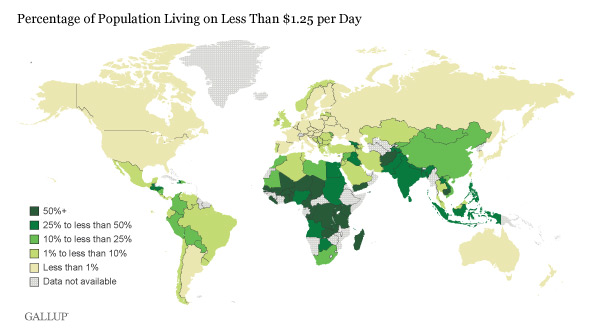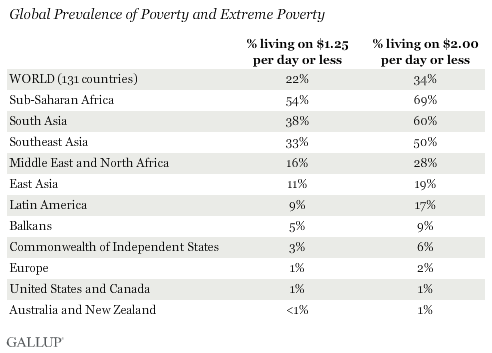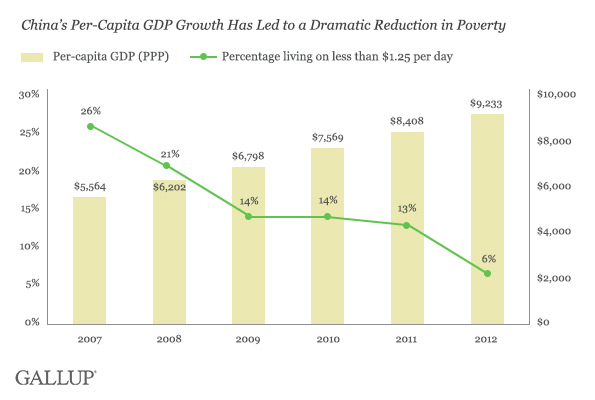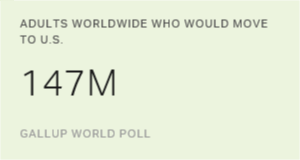WASHINGTON, D.C. -- Gallup's self-reported household income data across 131 countries indicate that more than one in five residents (22%) live on $1.25 per day or less -- the World Bank's definition of "extreme poverty." About one in three (34%) live on no more than $2 per day. The World Bank Group recently set a new goal of reducing the worldwide rate of extreme poverty to no more than 3% by 2030, but Gallup's data suggest meeting that goal will require substantial growth and job creation in many countries. In 86 countries, more than 3% of the population lives on $1.25 per day or less.

Gallup's worldwide income data offer a new look at commonly agreed on poverty thresholds. These measures include the proportion of a population living on $1.25 per day or less (the average poverty line for the world's poorest 10 to 20 countries) and the proportion living on $2 per day or less (the average of the national poverty lines for developing countries). Poverty estimates reported in Gallup's database adopt these definitions based on self-reported per-capita household income data gathered between 2006 and 2012 and expressed in international dollars (calculated using the World Bank's individual consumption PPP conversion factor).
Majority Across 27 Sub-Saharan African Countries Living in Extreme Poverty
The 10 countries with the highest proportion of residents living on $1.25 per day or less are all in sub-Saharan Africa. In each of them, more than two-thirds of residents are living in extreme poverty; in Burundi and Liberia, that proportion nears 90%.
Combining results from 27 sub-Saharan African countries for which data are available reveals that 54% of residents are living in extreme poverty -- easily the highest proportion among global regions worldwide. By contrast, in the economically developed regions of Australia and New Zealand, Europe (excluding the Balkans), and the U.S. and Canada, no more than 1% of the population lives on $1.25 per day or less.

China's Extreme Poverty Rate Falls by Nearly Three-Fourths Since 2007
World Bank President Jim Yong Kim recently noted that the proportion of the global population living in extreme poverty fell by half from about 40% in 1990 to about 20% in 2010. China's remarkable growth accounts for most of that decline, with hundreds of millions of Chinese to escape poverty during that time.
Gallup interviews more than 2,000 respondents each year in China, allowing for reliable tracking of the decline in poverty rates based on self-reported income over the past six years. Over that limited span, the trend is remarkable: In 2007, 26% of Chinese lived on $1.25 per day or less. Two years later, this figure fell sharply to 14%. After levelling off during the global recession, the downward trend resumed, with extreme poverty falling from 13% in 2011 to 7% in 2012.

Bottom Line
Past cross-country poverty assessments have been complicated by differing approaches to measurement, including absolute vs. relative definitions of poverty and different conceptions of acceptable living standards. However, the need to track poverty levels on a global scale -- particularly in support of poverty-alleviation targets set by the United Nations, the World Bank, and others in the international development community -- has led to some convergence on standardized definitions of poverty and extreme poverty. Gallup's newly released income data offer researchers another source for cross-country poverty assessment based on these definitions and using consistently high methodological standards worldwide.
Ming-Yi Wu contributed to the analysis in this article.
For complete data sets or custom research from the more than 150 countries Gallup continually surveys, please contact us.
Survey Methods
Results are based on telephone and face-to-face interviews with approximately 1,000 adults, aged 15 and older, per survey administration. Income data come from interviews were conducted in 131 countries and regions from 2006 to 2012. Data for each country have been aggregated over multiple administrations; at least 2,000 interviews are required for a country to be included in the income data set. For results based on each sample of national adults, one can say with 95% confidence that the maximum margin of sampling error ranged from a low of ±1.4 to a high of ±4.7. The margin of error reflects the influence of data weighting. In addition to sampling error, question wording and practical difficulties in conducting surveys can introduce error or bias into the findings of survey data.
With some exceptions, all samples are probability based and nationally representative of the resident population aged 15 and older. Exceptions include areas where the safety of interviewing staff is threatened, and in some countries, scarcely populated islands or areas that the interviewers can reach only by foot, animal, or small boat.
For more complete methodology and specific survey dates, please review Gallup's Country Data Set details.
